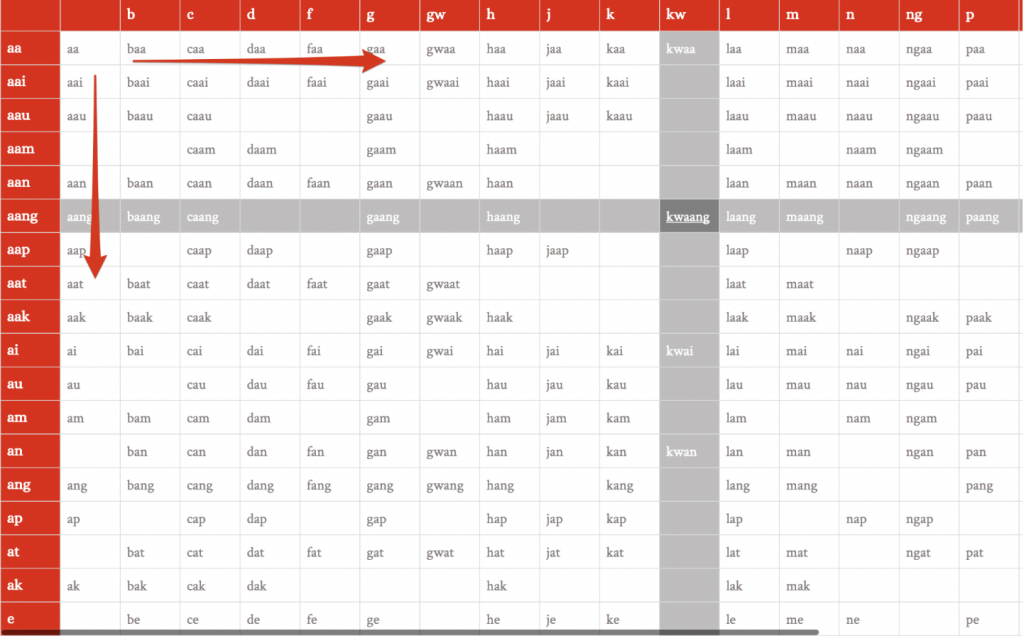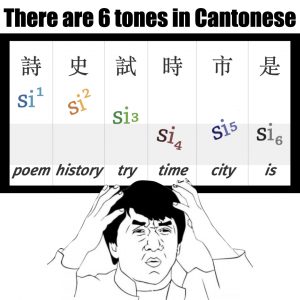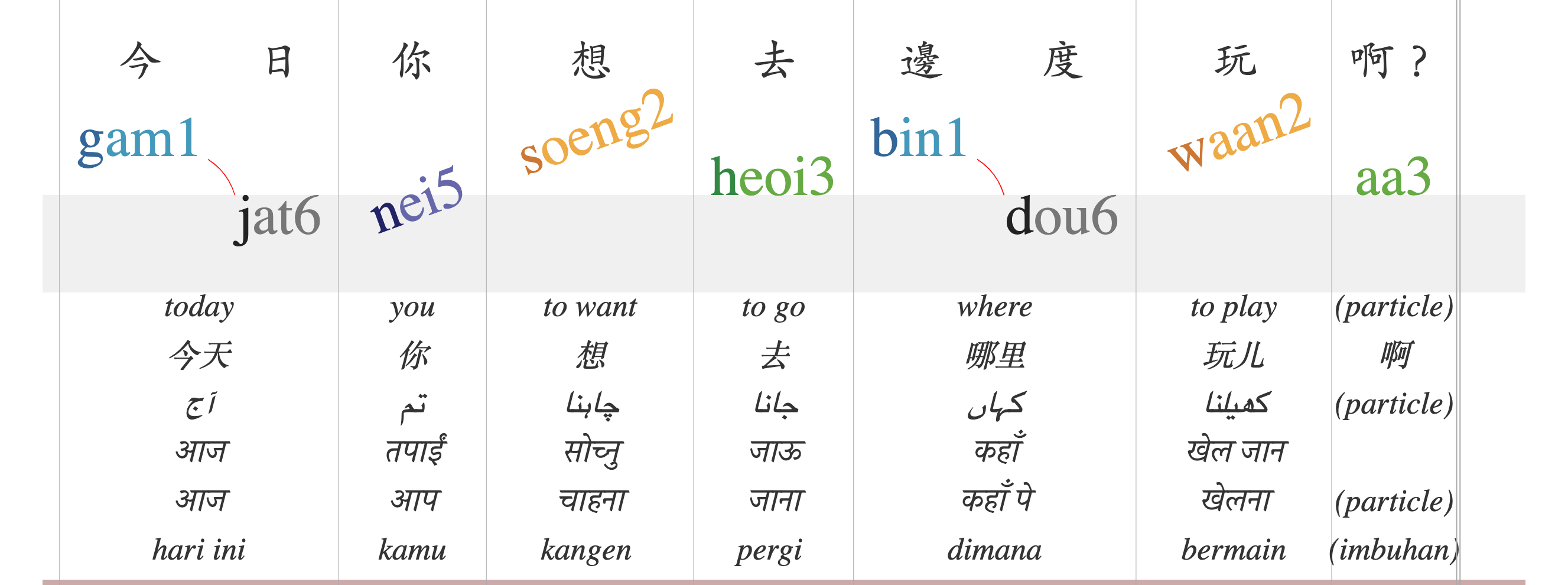The Importance of Jyutping in Learning Cantonese
1. How a romanization system facilitates Cantonese learning
A) Predictable
The writing system of Cantonese is Chinese characters, and the classification of Chinese characters are logogram in Linguistic studies. This means one cannot directly notice the pronunciation of a Chinese character just by reading it, because Chinese characters did not show every single phoneme. We can directly notice the pronunciation of a word in the case of phonemic characters. In English, the pronunciation of the letter b is always /b/. In German, the pronunciation of sch is always /ʃ/. Chinese Characters are totally different, although over 90% of them are pictophonetic characters, the series of words having the same phonetic element can have totally different pronunciations. Compare「伊」and「尹」, the phonetic element of 「伊」is「尹」, but the pronunciations are ji1 and wan5 accordingly. In this case, the Initials, finals and tones are totally different. In order to systematically describe the pronunciation of Cantonese, a romanization system is inevitable.

B) Confidence and agency
Even if a beginner does not need to learn Chinese characters, a romanization system for Cantonese is still needed. There are about 19 initials, 53 finals, and 6 tones in Cantonese. The numbers of these initials, finals and tones are limited, even the combination of them is limited. If one can master a romanization system, the next time when they come across the same initials, finals and tones, they would know how to pronounce Cantonese. For example, If one has learnt the initial /d/, he would be able to pronounce all the Cantonese words with the same initial /d/.

Source: Cantolounge
C) Clarity
Moreover, some of the phonemes are easily mixed up. The romanization system is a useful tool to help students distinguish the difference in different phonemes. For example, the 2nd and 5th tone, the 3rd and 6th tones are tones that are easily mixed up. The initials ng and zero consonant, the syllable coda -n and -ng, -t and -k are easily mixed up. Even for people who speak Cantonese as their mother tongue, these phonemes are still difficult for them to distinguish. By checking the phonetic transcription of two words, one would know whether the pronunciations are the same or not. If not, what are the differences?

2. Why do we choose Jyutping?
A) So many options.
Putonghua in Mainland China and Mandarin in Taiwan, have one leading romanisation system that is mandatory teaching for native and non-native students. This is not the case for Cantonese. There are so many ways of romanization for Cantonese, the romanization of a person’s name and streets’ name by the Hong Kong Government is a way, and the informal romanization used in Whatsapp is another way. Formal systems like Yale and Jyutping are the leading methods used in formal Cantonese teaching. Scholars typically use International Phonetic Alphabets(IPA). This diversity and variety are not very common compared to other characters like the hiragana and katakana used by the Japanese, and Hangul used by Koreans. Why we choose Jyutping is worthwhile explaining.

The character ‘樹’ is romanized as ‘Shue’ or ‘Shuo’ in streets’ names
B) Features
In order to choose a suitable romanization system, it has to meet the following requirements.
- One phoneme only represent by one kind of symbol
- One symbol only represents one kind of phoneme
- Popular enough that many people understand
The romanization of a person’s name and streets’ name by the Hong Kong Government and informal romanization used in Whatsapp would not be considered, because these two systems do not meet requirements a and b. For example, 「邨」could be transcripted to “tsuen” or “chuen”, “ts” and “ch” represent the same phoneme, violating requirement a. “Chun” is used to transcript 「俊」and「珍」, “un” is used to represent two different finals “eon” and “an” accordingly, which violates requirement b. Moreover, these two systems do not mark tones, so that these are not a good way of romanization for Cantonese. Many taxi drivers and passengers will attest to having experienced mild anxiety in getting destinations understood.
Most dictionaries use Jyutping. IPA is very exact. So why is Jyutping chosen, but not IPA? Our digital lives have one more requirement to consider.

- keyboard input friendly
C) Jyupting Vs IPA
Theoretically, IPA can transcribe all human verbal languages, that is why there are so many characters in IPA that are not Roman characters. IPA is very exact, one single symbol only represents one phoneme(or one phone). For example, IPA’s /ŋ/ corresponds to ng in Jyutping, /ŋ/ is only one symbol, ng is two symbols. However, the pronunciation /ŋ/ cannot be broken down to /n/ and /g/. IPA’s exactness comes at the cost of convenience in typesetting and data entry.
Jyutping is easily typed by keyboards. There are other advantages. Many Hong Kong people do not know how to type Chinese characters by strokes (such as Changjie and Q9 input method), because they might not know Chinese Characters (just know how to speak Cantonese), or they know Chinese Characters but do not know how to type. If these people know Jyutping, they can check the pronunciation in dictionaries, and at the same time they can type Chinese Characters without knowing Changjie (and Q9, etc). Even adults who master Chinese Characters and the input method, sometimes may forget how to write a specific word, they can type Chinese characters by Jyutping input too.
3. Conclusion
In learning Jyutping, Hong Kongers who speak Cantonese could know the precise pronunciation of words in Cantonese (and Chinese Characters). Jyutping is also a powerful tool for people to learn Cantonese with zero foundation. Jyutping can be an input method for most Hong Kong people and digital content creation by machine translation. Jyutping is not just a phonemic transcription, but also a necessity in learning Cantonese.
Learning Jyutping? Grab a native Cantonese speaker to give you a hand and find resources here 10-week Course for Jyutping Typing
中文版全文請去呢度。The full version of this article in Chinese is available here.
【Hambaanglaang Jyutman】
Cantonese Graded Readers
The Full Collection: 8 Sets/40 Books

This Full collection of Hambaanglaang Cantonese graded readers contains 8 sets (40 books) created by Hongkongers:
-
Written in Cantonese, you read what you speak.
-
Based on the HBL Graded Scale, designed according to the frequency studies by universities and referenced from Lexical Items for Fundamental Chinese Learning (HKEDB)
-
Original Graphical Jyutping Romanisation, learn to pronounce Cantonese visually and easily
-
Youtube and Soundcloud recordings, for reading and listening
-
Cantonese-English translation and “Same images, different stories in Cantonese and English”
-
A wide variety of stories created by the community, cultural introduction included enhancing the joy of reading.



